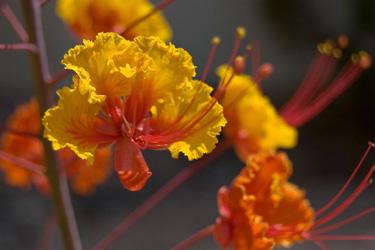
4 minute read
Landscaping
Landscaping Picking Plants for Small Spaces
With many people spending larger amounts of time at home this year, now is a great time to replant your flower beds, pots, and plants on your patio or other outdoor areas. But that’s not as easy as simply going to the nursery and picking out plants based on their appearance.
In Grayhawk, DLC Resources puts a lot of thought into selecting any new plants. They always have to fit our “Right Plant, Right Space” motto. That means that we carefully consider several factors before choosing new plants: how much sun or shade the area receives, the amount of space they’ll have to grow, and moisture needs. We also take plant appearance and the overall look we want to achieve into consideration.
You can take a similar approach to choosing plants for your small outdoor spaces. With a bit of planning and a few considerations, your patio or side-yard will not only look great, your plants will also be healthy. Make sure you consult Grayhawk’s Approved Plant List before choosing your new additions.
SUN EXPOSURE
As always, one of the very first things to consider whenever you’re selecting any new plant is the amount of sunlight the area will get. Being so close to tall buildings and fences, your yard and patio can fluctuate drastically between full sun and full shade throughout the day. Make sure you understand how the sun moves through your space throughout the day. Keep in mind that sun exposure may not be consistent throughout your small space either. Walls, overhangs , and roofs can create vast differences between one side of your patio, side-yard, or backyard and the other.
WATER CONSIDERATIONS
As always, choose plants that are desert-adapted or native. Not only will they do better in our desert climate, they’ll also help keep your water bills down. But that’s not the only water-related factor to take into consideration. Infrastructure in small spaces can create micro-environments. Be aware of how rainwater moves throughout your small space:
What kind of drainage do your raised beds or planter pots have? Does water tend to pool in one corner of your yard after heavy rains? Does a particular flowerbed get inundated with rainwater dripping from your house’s eves?
POOL PLANTS
Aside from the above considerations, plants around pools need to fit one more criteria: how much litter do they create? You generally don’t want to put a Mesquite or Palo Verde tree overhanging your pool — unless you really like the idea of fishing bean pods or flower petals out of the water. Take the time to research how much litter — whether it’s falling leaves in the autumn, bean pods or spring flowers — your poolside plants will create.
Also, keep in mind what activities you’ll be doing around the pool. Cacti with very prickly spikes — like the Prickly Pear and Golden Barrel — may not be the best choice for pool areas where bare feet or inflatable pool toys are common.
COURTYARDS
Courtyards are especially tricky when it comes to lighting. Because they’re enclosed on all four sides, some areas may never get direct sunlight while other courtyard areas have to deal with very intense sunlight for a few hours each day. Before you choose
plants for your courtyard, spend a few days just observing how the sunlight moves through your space; understand which areas get sun, when and how much. Consider that the lighting will change drastically throughout the year as well. Pick plants for each specific light area rather than trying to use the same plants throughout your entire courtyard.
Also, consider full-grown plant sizes. Since courtyards tend to be fairly small, choose plants with a similar scale. That way, you won’t have to worry about constant pruning — which is not healthy for the plant.
BACKYARD PERKS
While all of the considerations may make small spaces and backyards seem limiting for plant selection, there are some perks. Choosing plants for enclosed spaces means you don’t have to worry as much about animals eating them. With walls and fences to keep out javelina and rabbits, your backyard is the perfect place to plant those species especially prone to damage: Agave (especially the Century Plant), Red Yucca and delicate annual flowers.
SOME OF OUR BACKYARD PLANT SUGGESTIONS
When picking out plants for your patio areas, keep in mind what function you would like the plant to serve and the overall look you’d like to achieve. Also, make sure you know the plant’s full-grown size; some larger shrubs might quickly outgrow their designated space in smaller areas on your property. Here are some of our suggestions for patio plants.
• To build privacy or divide your patio space, shrubs like the
Hopbush grow tall and are easily shaped. They can easily create a wall for privacy.
• Ocotillos are always a nice option to add height without taking up too much valuable space near your small patio areas.
• Colorful plants are always a nice addition to add interest and variety. Red Bird of Paradise, Yellow Bird of Paradise and
Firecracker Bush and Coral Vine are all good options.

EXPERIENCE | INTEGRITY | COMPREHENSIVE


STATE-OF-THE-ART DENTAL SERVICES • CEREC Single Visit Crowns • Sleep Apnea • Cosmetic and General Dentistry • Implants • Invisalign • TMJ Therapy • In-Office Whitening
DENTAL SAVINGS PLAN IMMEDIATE ELIGIBILITY | NO MAXIMUMS NO WAITING PERIODS | NO DEDUCTIBLES NO CLAIMS TO FILE | NO PRE-AUTHORIZATIONS INVISALIGN | IMPLANTS | CROWNS | VENEERS






